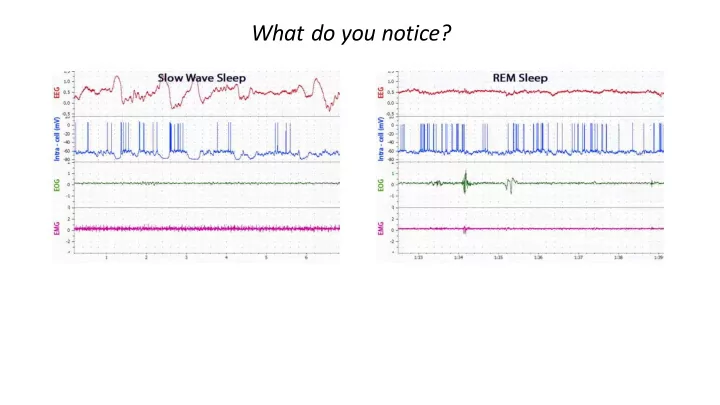

What do you notice?
Sl Slow wave ne netwo works Crunelli and Hughes, Nature Neuroscience , 2010
The resonance properties (frequency preference) of neurons in the thalamus and cortex contribute to rhythms in slow-wave sleep: Slow-wave : cortical neuron resonance (persistent sodium channels) Delta rhythm : thalamocortical neuron resonance (HCN channels and low-voltage-activated Ca 2+ channels) Spindles : reticular thalamus neuron resonance (low-voltage-activated Ca 2+ channels) The observed rhythms are also dependent upon connectivity within thalamocortical circuits: A volley of excitation in the cortex during the UP-state of the slow wave, elicits a cascade of rhythmic events in the thalamus.
So far, we have discussed several mechanisms for generating rhythmic activity in the brain. Can the timing of neural activity have a specific function?
Functional consequences of the slow wave A reorganization of cortical networks: Pair the EPSP with current injection to induce bursting Stimulate outside the Smaller EPSP indicates cell to produce an EPSP reduced efficacy of in superficial layers excitatory synaptic connections Bertoli and Ulrich , J. Neuro ., 2004
Functional consequences of the slow wave A reorganization of cortical networks: EPSP paired with a burst of action potentials EPSP paired with a single action potential Bertoli and Ulrich , J. Neuro ., 2004
Functional consequences of the slow wave A reorganization of cortical networks: Synchronous EPSPs and action potentials at spindle frequencies Enhances the efficacy of excitatory synaptic connections Rosanova and Ulrich , J. Neuro ., 2005
Links to behavior and cognitive processes What is this plasticity (flexibility) good for? Slow-wave sleep has important links to memory consolidation: Slow wave activity is locally enhanced after performance of a motor task, and motor task performance is improved after sleep (Huber et al., Nature , 2004). Huber et al., Nature , 2004
Links to behavior and cognitive processes What is this plasticity (flexibility) good for? Slow-wave sleep has important links to memory consolidation: During UP-states, cortical cells “replay” experiences that occurred earlier during wakefulness (Daoyun and Wilson, Nature Neuroscience , 2007). Daoyun and Wilson, Nature Neuroscience , 2007
Links to behavior and cognitive processes What is this plasticity (flexibility) good for? Slow-wave sleep has important links to memory consolidation: Improved declarative memory after transcranial alternating current stimulation experiments that enhance slow waves and spindle oscillations, but not after experiments that enhance faster rhythms (Marshall et al., Nature , 2006) Marshall et al., Nature , 2006
Links to behavior and cognitive processes What is this plasticity (flexibility) good for? Hypothesis : Slow-wave sleep is important for recalibrating the strength of synapses, enhancing the signal-to-noise ratio of stored (learned) information. Vassalli and Dijk, EJN , 2009
So far, we have discussed several mechanisms for generating rhythmic activity in the brain. Can the timing of neural activity have a specific function?
Recommend
More recommend